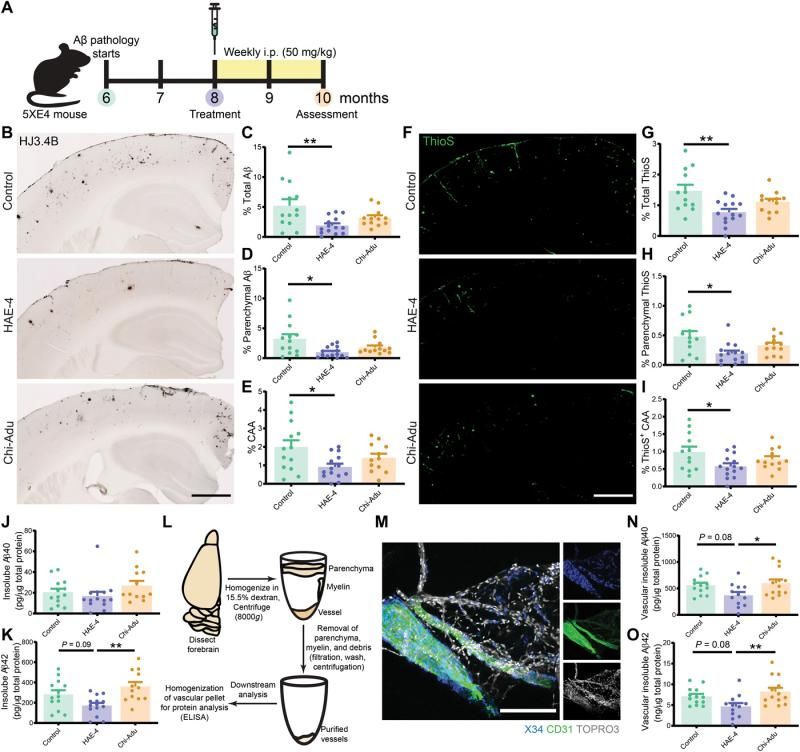Abstract: As people grow older, a normal cerebroprotein called β amyloid(Aβ) protein aggregates to form harmful amyloid plaques in the brain. The plaques may be the first step for Alzheimer's disease. When they form cerebral amyloid angiopathy around blood vessel of brain, there is an increase in the risk of stroke. In an new APOE immunotherapy, researchers identify an anti-amyloid antibody.
Keywords: APOE Immunotherapy, Cerebral Amyloid Angiopathy(CAA), Alzheimer's Disease, Anti-amyloid Antibody, FineTest Antibody
1. Anti-amyloid Antibodies
Several targeted amyloid plaques antibodies have been used in the experimental treatment for the research of Alzheimer's disease. This kind of antibody may also have the potential in the treatment of cerebral amyloid angiopathy. However, they are not evaluated in clinical trial. All anti-amyloid antibodies successfully reducing amyloid plaques in the clinical trial of Alzheimer's disease also have a worried side effects in increasing the risk of cerebral swelling and hemorrhage.
2. Research on APOE Immunotherapy
Currently, in a new research, researchers from various research institutions including School of Medicine at Washington University in St. Louis identify an antibody which can remove amyloid plaques in the brain tissue and blood vessels instead of increasing the risk of cerebral hemorrhage. The antibody targets a minor composition of amyloid plaques, namely apolipoprotein E, APOE. The research results show the removal of harmful amyloid plaques is a potential safer method as a kind of treatment of Alzheimer's disease and cerebral amyloid angiopathy. Related research achievements are available in the article entitled "APOE immunotherapy reduces cerebral amyloid angiopathy and amyloid plaques while improving cerebrovascular function" published in Science Translational Medicine on February 17, 2021.

Figure Source: Science Translational Medicine, 2021, doi:10.1126/scitranslmed.abd7522
The corresponding author of the article Dr. David Holtzman, who is the head of Department of Neurology, School of Medicine at Washington University in St. Louis said: "For decades, Alzheimer's disease researchers always find the drug for reducing amyloid protein in the brain. Now, there are some hopeful drug candidates. We find they will result in the complication. In the clinical trial, each antibody removing amyloid plaques is different. However, they have this problem more or less. We adopt a different method for targeted APOE, which seems to effectively remove amyloid protein in the brain tissue and blood vessels and avoid the potential dangerous side effect".
3. Amyloid-related Imaging Abnormalities (ARIA)
The side effect called amyloid-related imaging abnormalities (ARIA) can be seen in brain scans. ARIA shows cerebral swelling or hemorrhage caused by inflammation may result in headaches, mental disorders and even seizures. In the clinical trial of anti-amyloid antibody, about 20% participants will have ARIA, although not all the people have the symptom.
The mechanism of anti-amyloid antibody is a reminder of the existence of redundant substances - amyloid plaques for immune system and guide the inflammatory cells called microglia to remove these fragments. ARIA seems to be the result of overactive inflammation. Holtzman and Monica Xiong(the first author) guess an antibody just against a small part of the amyloid plaques may result in more restrained immune reaction and remove amyloid plaques in the brain tissue and blood vessels instead of causing ARIA.
4. HAE-4 Antibody
Fortunately, these researchers have the antibody called HAE-4 antibody, which targets a specific human APOE and causes the removal of amyloid plaques in the brain tissue. The APOE sparsely exist in amyloid plaques. In order to identify whether HAE-4 can remove the amyloid protein in blood vessel of brain, they use encoded human amyloid protein modified by the gene and a mouse with APOE4 gene relevant to the high risk for Alzheimer's disease and cerebral amyloid angiopathy. When the mice are about six months-old, a large amount of amyloid plaques appear in their brain tissue and blood vessels.
The experiment shows amyloid plaques in brain tissue and blood vessels can be reduced after eight weeks of treatment for these mice by HAE-4. The treatment also obviously improve the ability of cerebral vasodilation and vasoconstriction on demand. This is the important indicator for vascular health.
Amyloid plaques in cerebral vessels are dangerous because they may result in blocking or rupture which thereby causes stroke. These researchers compare the number of cerebral hemorrhage, after mice are treated by using HAE-4 or the anti-amyloid antibody called aducanumab applied in the treatment of Alzheimer's disease during the 3rd stage clinical trial for eight weeks. The slight cerebral hemorrhage of these mice is at the baseline level, because their genetic susceptibility results in the aggregation of amyloid protein in blood vessels. However, aducanumab obviously increases the number of cerebral hemorrhage except HAE-4.
The further research shows the intensity of initial immune reaction against amyloid plaques caused by HAE-4 and aducanumab is similar. However, the inflammation of mice treated by the anti-APOE antibody(HAE-4) is removed in two months. However, the inflammation of mice treated by anti-amyloid antibody(aducanumab) still remains.
5. Conclusion
Dr. Holtzman said: "Some people suffer cerebral amyloid angiopathy but never suffer Alzheimer's disease. They may still suffer stroke. The aggregation of amyloid protein in cerebral vessels can be managed by controlling blood pressure and other things. But there is no specific treatment. The research is exciting. It shows both we can treat the disease in the animal model and we can also conduct the treatment without side effects of other anti-amyloid drugs".
6. FineTest Amyloid Products
Browse a list of amyloid products provided by FineTest.
REFERENCES
[1] Monica Xiong et al. APOE immunotherapy reduces cerebral amyloid angiopathy and amyloid plaques while improving cerebrovascular function. Science Translational Medicine, 2021, doi:10.1126/scitranslmed.abd7522. PMID: 33597265
[2] Protein linked to Alzheimer's, strokes cleared from brain blood vessels.
